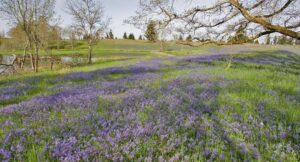For over six years farmers, development interests and conservation advocates eagerly waited for a Habitat Conservation Plan (HCP). This 30-year plan will cover the entireThurston County outside the cities’ urban growth area. It targets four endangered animals—the Mazama pocket gopher, Oregon vesper sparrow, Oregon spotted frog, and Taylor’s checkerspot butterfly.

Getting building permits faster, easier and cheaper
Currently if an endangered animal lives on a property, the owner has to apply for a federal “incidental take permit” to build any structure, from a shed to a huge truck depot. The process can take a year or more and is expensive. The landowner must create a mitigation plan to conserve land for the endangered species, but there is little monitoring to check whether the plan actually works.
Lands in Thurston County have been surveyed for prairie soils, types of vegetation and the likely presence of an endangered species. After the HCP is implemented, property owners can apply for a county permit under the HCP at the same time as their other building permits. The HCP includes a system to categorize each land parcel from high to low, according to their suitability to support endangered wildlife. County staff will use that system to compute mitigation fees for each building project. The fees will go into a county fund to conserve prairie habitat.
Conserving rare species and protecting disappearing habitat
The HCP focuses on four endangered wildlife species, but it will protect some of the best oak-prairie habitat left in the United States. This ecosystem contains other plants and animals that are also increasingly rare but not yet listed as needing protection.
The “oak-prairie-wetland ecosystem matrix” was formed millions of years ago by glaciers that left gravelly soils that drain well and become totally dry during the summer. The prairies stretch from northern California to lower British Columbia, but only 1% remain from before European settlement.
The Oregon White Oak, sometimes called Garry Oak, occurs only rarely on these prairies in western Washington and Oregon. On the edges and in lower areas are streams and wetlands. Plants and animals became adapted to this unique ecosystem and are now at risk of extinction as the habitat is degraded or disappears.
Through controlled burning, Native Americans maintained the prairies for over 5,000 years to promote medicinal plants and edible plants like camas bulbs and berries. Modern-day prairies must be managed to prevent intrusion of native evergreen trees and non-native invasive plants like pasture grasses and Scotch Broom.
A resource for improved stewardship
Over time the HCP should create higher quality prairie preserves in contrast with the mitigation areas conserved under the present system. The HCP mitigation fund will buy some new preserves where endangered species are present. Humans will benefit as well as wildlife from the services provided by these open spaces, especially in relation to flood control and carbon sequestration.
Over time the HCP should create higher quality prairie preserves in contrast with the mitigation areas conserved under the present system.
The fund will also pay for monitoring and adaptive management to conserve both new and old preserves. When combined with restoration efforts from agencies, tribes, land trusts, and nonprofits, the future looks brighter for our beautiful and unique prairies.
This fall the public can submit comments to the County Planning Commission on the Draft Environmental Impact Statement (EIS) for the Habitat Conservation Plan. Staff will consider those comments when drafting the Final EIS, and the County Commissioners’ approval could come within a year.
To learn more about our prairies or how you can visit or volunteer to help them, visit South Sound Prairies.
